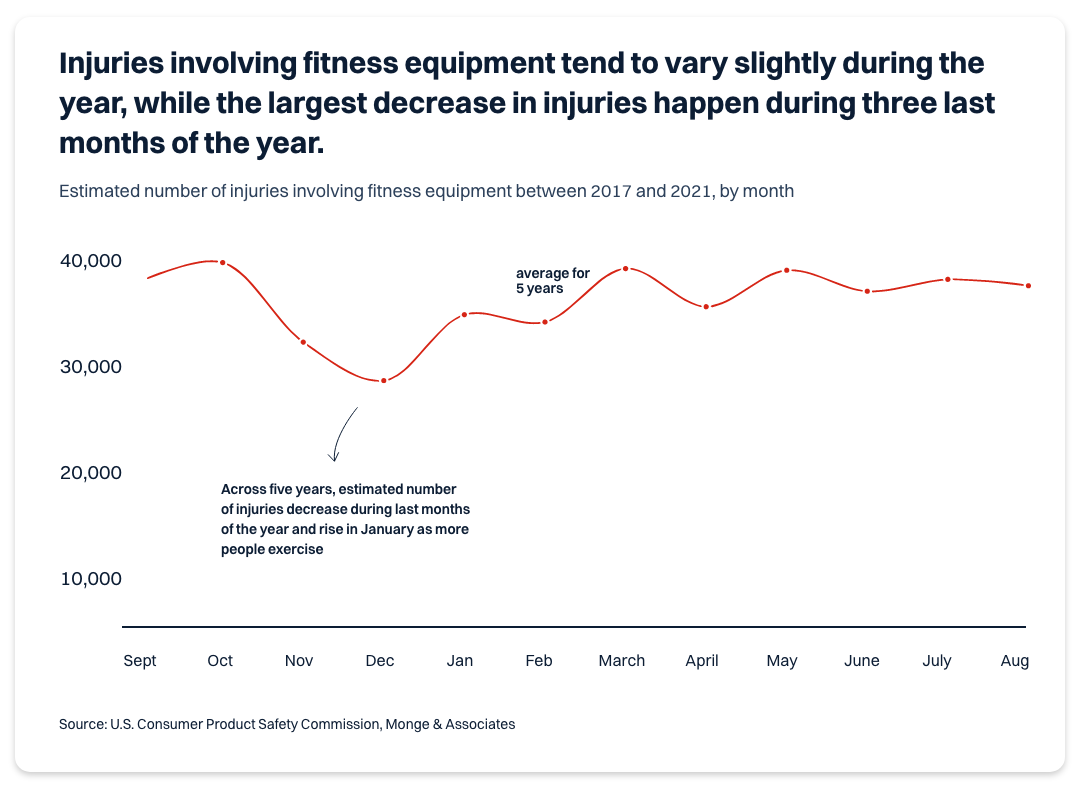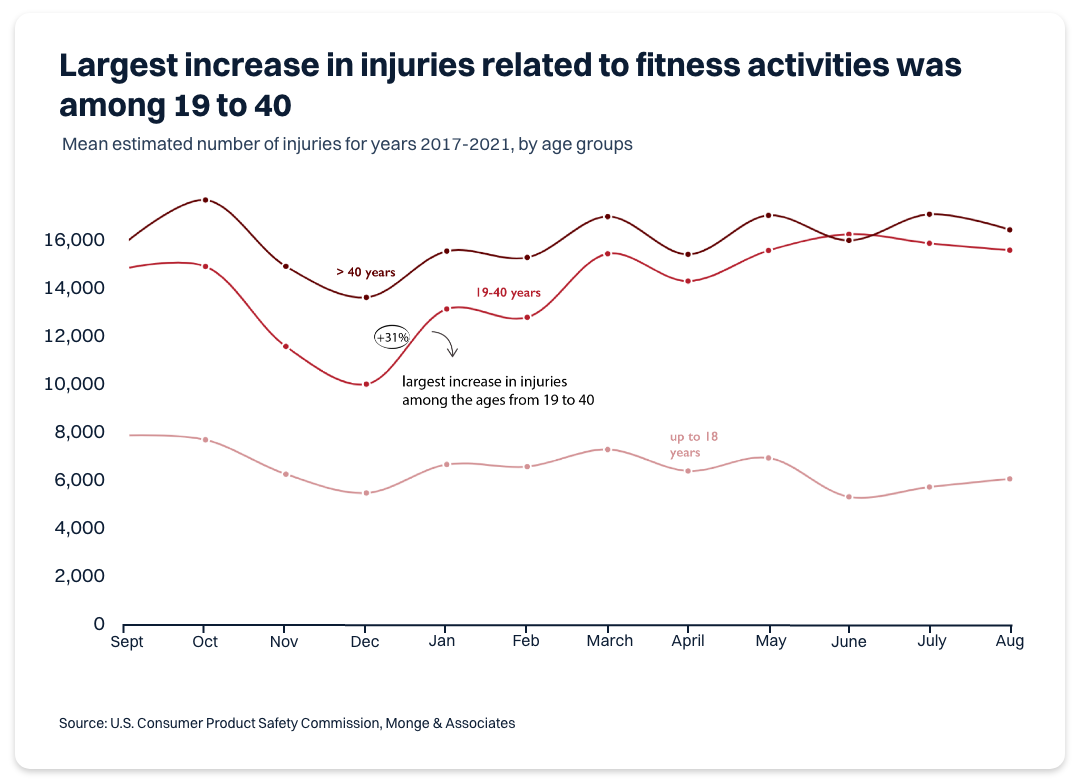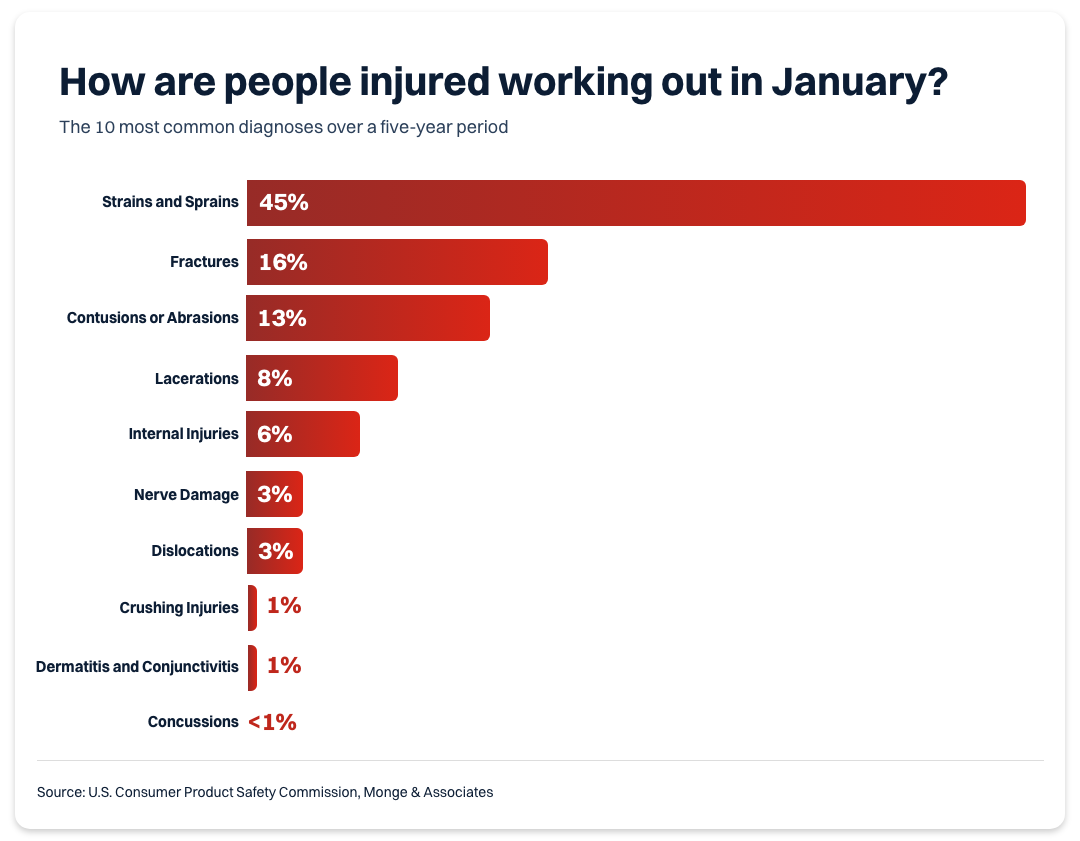U.S. emergency departments see sharp increase in fitness-related injuries in January

Canva
U.S. emergency departments see sharp increase in fitness-related injuries in January
five people working out in a gym on doing different exercises
At the beginning of each year, millions of Americans embark on a journey of self-improvement in the form of New Year’s resolutions. While people set goals for a variety of reasons, the most common resolution among U.S. adults is to improve physical fitness.
According to a survey conducted by Forbes, 48 percent of resolutions involve improving fitness and 34 percent involve losing weight. As a result, there is a huge influx of interest in fitness and exercise in January each year.
Unfortunately, this resolution-driven increase in activity often results in serious injury.
Monge & Associates, a consumer injury law firm based in Atlanta, analyzed five years of Emergency Department visit data from the United States Consumer Product Safety Commission (CPSC) to quantify this increase. The analysis found that over 35,000 people visit the emergency room annually as a result of a workout injury in January – an increase of nearly 22 percent over December.
![]()

Monge & Associates
There is a clear dip in reported injuries in the last few months of each year and a rise in injuries each January
line graph showing average number of fitness-related injuries in the U.S by month
This early-in-the-year increase typically extends through March – as more people begin their New Year’s resolutions to exercise more.
This surge in workout-related injuries in January can be a result of several factors. Exercise levels during the holiday season tend to drop drastically, so after the dip in activity in December, the number of injuries steadily rises in January as more people start returning to the gym or taking up new habits. The abrupt increase in physical activity after a period of inactivity can inflict strain on the body. When re-entering the gym, after weeks, months, or years off, it can be easy to overexert the body if too eager an approach is taken.

Monge & Associates
Who is most at risk?
graph showing mean number of estimated injuries by age group, by month, in the U.S for five years
An increase in strenuous activity – especially after a long period of inactivity – can put anyone at a higher risk of injury. However, the group that sees the largest increase in workout-related injuries in January is those between the ages of 19-40 years old. Injuries in this age group increase an average of 31% in January.
Those over 40 account for more total injuries than any other group during the observation period, though the increase in workout-related injuries in January is not as drastic as within the 19-40-year-old group.
Additionally, men are much more likely to be injured than women, accounting for nearly 30 percent more emergency room visits than men in January.

Monge & Associates
How are people hurt?
A bar hart showing the various ways people are injured during workouts in the month of January.
Ramping up too quickly, continuing to train through an injury, or unfamiliarity with a machine or technique; there are a variety of ways that people can become injured working out. What diagnoses were most common among emergency room visits in January?
Where a specific injury was reported, sprains and strains were most common and accounted for 45 percent of all diagnoses. Fractures were the next most common at 16 percent of diagnoses and contusions or abrasions, third, made up 13 percent.
The five most common diagnoses
1. Sprains and strains
The CPSC estimates that over 9,200 people visit the emergency room in January after experiencing a significant strain or sprain while working out. Sprains were most common in situations where the patient reported a new increase in activity or lifting too much weight.
A 62-year-old male felt a pop after lifting a weight over his head.
A 34-year-old woman reported pain and increased swelling to the left knee after running an increased number of miles.
A 31-year-old man reportedly overdid it lifting weights and developed abdominal and chest wall pain.
2. Fractures
Fractures account for more than 3,300 emergency room visits in January each year – nearly 16 percent of all diagnoses. Bone fractures were very common in incidents involving treadmills and dropped weights.
A 48-year-old patient was lifting weights when he dropped a 45-pound dumbbell on his left foot.
A 19-year-old man fractured his finger after a weight fell on it.
A 47-year-old patient fractured her tibia after falling off of a treadmill.
3. Contusions and abrasions
Contusions and abrasions were the third most common diagnosis, accounting for nearly 2,600 E.R. visits each January. They represent 13 percent of all exercise-related diagnoses during the month. Contusions and abrasions often occurred after falls while running.
A 59-year-old woman tripped while trail running, striking her lower knee and leg on a rock
A 39-year-old patient slipped and fell while hiking, leaving her with contusions on her hand and knee.
A 19-year-old fell while running, resulting in a severe facial abrasion.
4. Lacerations
Over 1,700 people visit U.S. emergency rooms in January after suffering lacerations while exercising – accounting for 8 percent of diagnoses. Laceration injuries happened in a variety of settings and situations, including:
A 17-year-old suffered laceration injuries to his lower extremities while box jumping after hitting both shins on the corner of the box.
A 19-year-old male suffered a scalp laceration after the bar fell when they attempted to do pull-ups.
A 47-year-old patient suffered a thumb laceration after falling off of an exercise bike.
5. Internal injuries
Internal injuries accounted for just under six percent of diagnoses, an average of around 1,200 per January. In many cases, falls, overexertion and other complications lead to severe internal injuries, including closed head injuries, hematomas, and intracranial hemorrhages.
A 59-year-old man suffered a spleen contusion after falling onto a dumbbell.
A 28-year-old woman suffered a seizure after passing out following prolonged use of a stationary bike.
A 48-year-old woman suffered a closed head injury after hitting herself in the head with a 20-pound dumbbell.
How to avoid injury
Embarking on a new workout routine in the New Year can be exciting as you begin your journey toward improved health and well-being. While it is impossible to completely remove the risk of injury from any activity, there are several steps you can take to reduce it. For a sustainable start to your fitness journey, here are some tips to help you avoid injury:
- Start slowly with manageable workouts that align with your current fitness level
- Gradually increase intensity, duration, and/or weight as you improve
- Set realistic goals to keep you motivated and on track
- Listen to your body by resting when you need it and not continuing to work out with an injury
- Prioritize your warm-up routine to properly prepare your muscles for activity
- Properly hydrate and fuel your body to help with performance and recovery
Incorporating good habits into your new workout routine and knowing your limits can help you minimize the risk of injury and help you stay consistent so you may attain your goals.
This story was produced by Monge & Associates and reviewed and distributed by Stacker Media.
